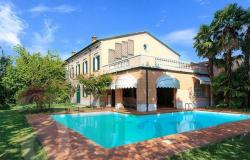 (ANSA) - An outstanding exhibition in this northern Italian town offers the public a unique opportunity to compare and admire the art of Vincent Van Gogh and Paul Gauguin.
(ANSA) - An outstanding exhibition in this northern Italian town offers the public a unique opportunity to compare and admire the art of Vincent Van Gogh and Paul Gauguin.
The quantity and quality of the material on show is such that organizers have described it as "certainly one of the most beautiful and complete exhibitions of masterpieces and emotions to have ever taken place in Italy."
Some 150 works by the two postimpressionist giants - 100 paintings and 50 drawings, sketches and other pieces on paper - have been borrowed from top international museums and galleries for the occasion. Many of the paintings have never been shown in Italy before.
Both of these revolutionary, tragic artists' careers are covered from start to finish at Gauguin Van Gogh - L'Avventura del Colore Nuovo (Gauguin Van Gogh - The New Colour Adventure).
Earlier Van Gogh pieces include a moving drawing of a nude women entitled Sorrow and several dark paintings produced in the Netherlands between 1882 and 1885, such as Head of a Peasant Woman, on loan from Edinburgh's National Gallery of Scotland.
A selection of paintings made in Paris and Breton looks at the earlier efforts of Gauguin who, like Van Gogh, started to paint relatively late in life and was largely self-taught. Another National Gallery of Scotland piece, Tropical Vegetation, is a delightful example of his evocative use of
colour, while works like Breton Peasants reveal his obsession with a simple way of life.
Two self-portraits feature in a section devoted to Van Gogh's spell in Paris between 1886 and 1888.
At first glance the two paintings look completely different - the first is realistic with the artist dressed in a suit, while the second is much more impressionistic and portrays him in a straw hat. But closer inspection reveals that the intense, troubled stare is almost identical.
For most visitors, the highlight of the exhibition will be the section devoted to the two months the artists spent together in Arles. Van Gogh, who had a great desire for companionship and dreamt of founding a brotherhood of artists, invited Gauguin to join him in the southern French town in 1888.
But the two were very different characters - Van Gogh was modest and unstable, Gauguin proud and ambitious - and the experience ended with Van Gogh attacking Gauguin in a fit of the madness that eventually drove him to suicide in July 1890.
Nevertheless, the spell was a highly productive one and Van Gogh's ability to express his emotions through use of colour was reinforced by it. Among the paintings on display from this period are Van Gogh's View of the Arles Viaduct and Gauguin's Women from Arles, on loan from The Art Institute of Chicago. In 1891 Gauguin left Europe for Tahiti in search of a primitive life that would give him the intensity of feeling his art needed.
A selection of the distinctive work he produced in the South Seas pays testament to his magnificent ability to enter into, and capture, the spirit of the native people he met. The South Sea Islands were undoubtedly good for Gauguin's art, but he was desperately lonely there, his health suffered and he died in 1903 at the age of 54. Another section features some of the beautiful creations Van Gogh made during intermittent moments of lucidity in the last year of his life.
These works really have to be seen in first person to be appreciated, as much of their appeal is in Van Gogh's use of brushstroke to express himself.
Gauguin Van Gogh - L'Avventura del Colore Nuovo runs at Brescia's Museo di Santa Giulia until March 19. There is an English-language version of the exhibition website:








